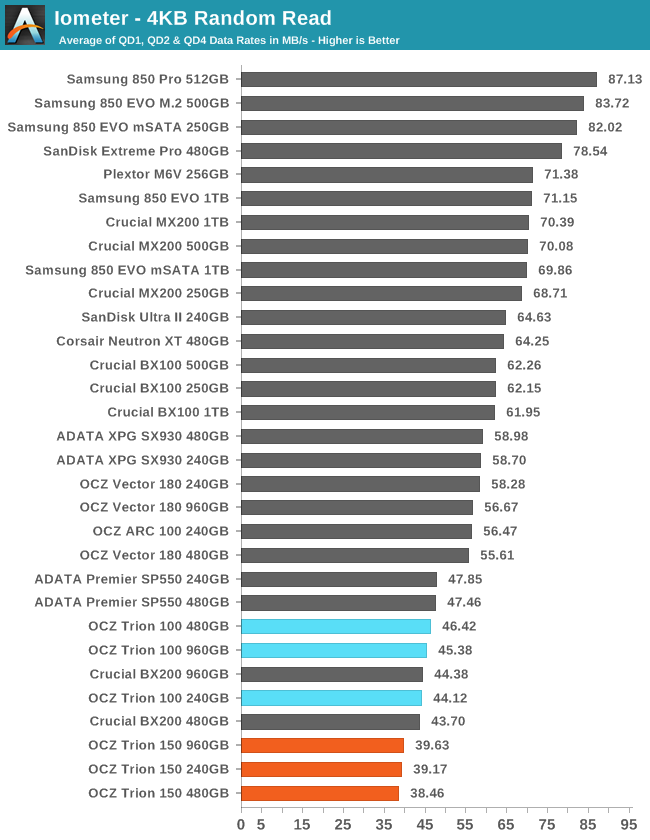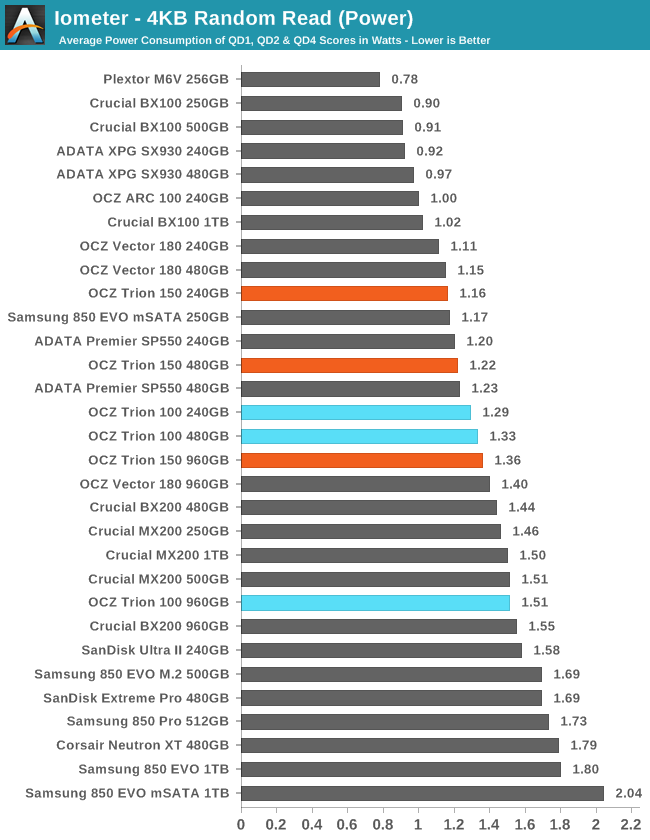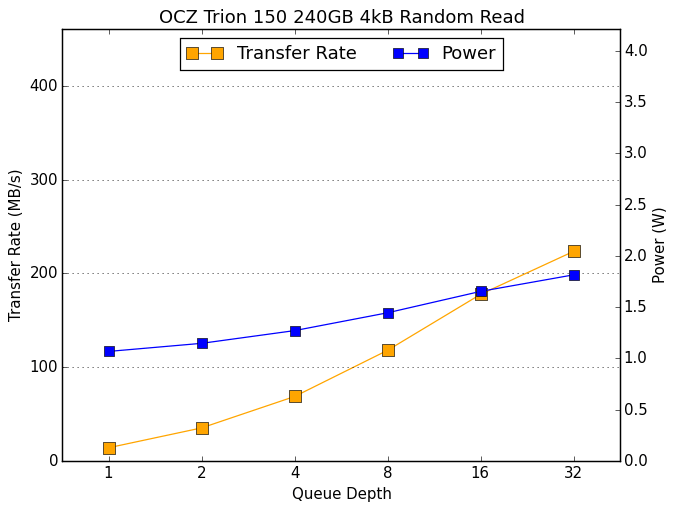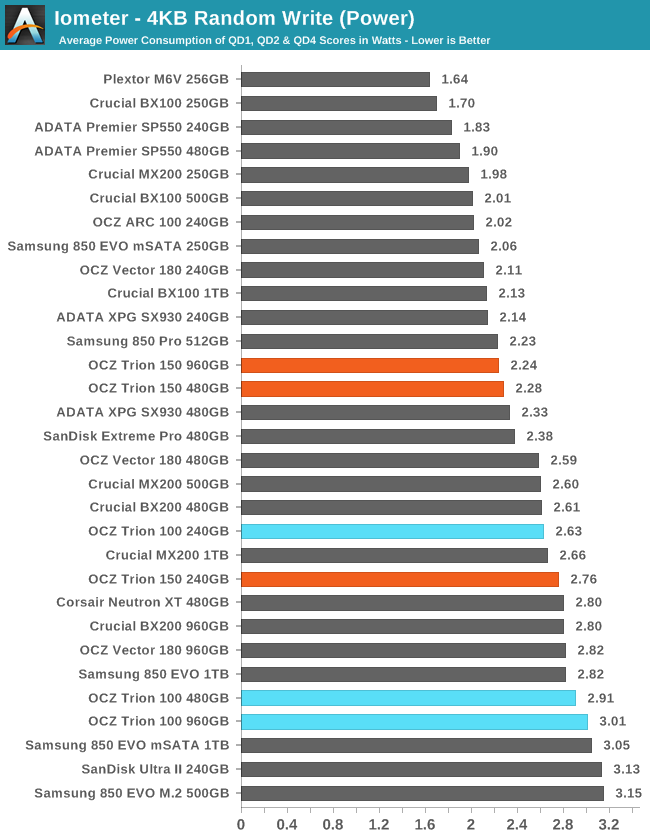The OCZ Trion 150 SSD Review
by Billy Tallis on April 1, 2016 8:00 AM ESTRandom Read Performance
The random read test requests 4kB blocks and tests queue depths ranging from 1 to 32. The queue depth is doubled every three minutes, for a total test duration of 18 minutes. The test spans the entire drive, which is filled before the test starts. The primary score we report is an average of performances at queue depths 1, 2 and 4, as client usage typically consists mostly of low queue depth operations.

The Trion 150 sets a new low for small queue depth random read speeds, with half the performance of the best SATA drives. This is probably the primary cause of the poorer latency scores seen on the ATSB tests. For context, the QD1 performance of the 480GB Trion 150 is still almost 50 times faster than a 7200RPM hard drive.

Power consumption has at least decreased in kind with the reduced performance, but the ADATA SP550 manages slightly better efficiency than the Trion 150 and most MLC drives are much more efficient.
 |
|||||||||
The 480GB Trion 150 doesn't perform quite as well at the highest queue depths as the other capacities, but all sizes perform considerably worse than the competition, especially at high queue depths.
Random Write Performance
The random write test writes 4kB blocks and tests queue depths ranging from 1 to 32. The queue depth is doubled every three minutes, for a total test duration of 18 minutes. The test is limited to a 16GB portion of the drive, and the drive is empty save for the 16GB test file. The primary score we report is an average of performances at queue depths 1, 2 and 4, as client usage typically consists mostly of low queue depth operations.

Random write speed on the 240GB Trion 150 got a huge boost over the Trion 100 and even the larger Trion 150s, but they all improved and widened the lead over SM2256 drives.

Power efficiency during random writes is much improved. The 240GB Trion 150 draws slightly more power than the 240GB Trion 100, but that's completely justified by the performance jump.
 |
|||||||||
The queue depth scaling behavior is quite odd. The 240GB Trion 150 doesn't change past QD4, but the larger sizes see a huge improvement moving to QD8 and beyond. This can make for some nice benchmark numbers but won't have much real-world impact. At low queue depths the 240GB comes out well ahead. This discrepancy is most likely a difference in the SLC caching configuration between the different models. Whatever the cause, the 240GB drive is making the better choices.










79 Comments
View All Comments
RBFL - Saturday, April 2, 2016 - link
What do you define as decent priced?xrror - Saturday, April 2, 2016 - link
The worst part I'm guessing is finding anything decently priced that isn't 1366x768. I hate that resolution so much. My keep looking to replace my old core2 craptop that wheezes along (sadly it uses the most gimped/market segmented version of the Intel 945GM chipset), But it uses an old school 1440x900 screen - and that vertical space I refuse to give up.Sorry folks, when I see 768 - that was only cool back when 1024x768 was an upgrade from VGA's 800x600. F going back.
Samus - Sunday, April 3, 2016 - link
Look at HP Elitebooks like the 820 and 840, they come standard with 1600x900 screens (which is a perfect resolution on the 12.5" 820.1920x1080 is fine and all on a 14"+ but really sucks on a 11-13" unless you have display scaling. Windows 7 and Linux it just sucks unless you have eagle vision.
BurntMyBacon - Monday, April 4, 2016 - link
@Samus: "Look at HP Elitebooks like the 820 and 840, they come standard with 1600x900 screens (which is a perfect resolution on the 12.5" 820."I do rather like that resolution for this size on a notebook. Tablets are generally used at a closer distance, but I digress.
@Samus: "1920x1080 is fine and all on a 14"+ but really sucks on a 11-13" unless you have display scaling. Windows 7 and Linux it just sucks unless you have eagle vision."
Yet I'd still rather see 1920x1080 than 1366x768 as I find it less frustrating to lean a little closer when I need to than to not be able to get the content I want on screen. Until better scaling is commonplace, 1680x1050 or 1600x900 please.
Arbie - Friday, April 1, 2016 - link
The link below is a 2011 review on Anandtech, showing Velociraptor scores vs SSDs of the time. You can estimate pretty well from that how things would compare now.FYI, the Mushkin Reactor 1TB MLC SSD (reviewed here recently) is available for $220 on NeweggBusiness.
http://www.anandtech.com/show/4337/z68-ssd-caching...
Samus - Sunday, April 3, 2016 - link
Excellent drive (the Mushkin Reactor) I have recommended it at least a dozen times and never heard a complaint. Stark contrast to the one person who didn't take my advice (I have two of them so I know how good they are) and bought the Sandisk Ultra II 960GB instead because it was $20 cheaper. It failed on them after 4 months. Which is alarmingly common if you read the reviews on Newegg.Ryan Smith - Friday, April 1, 2016 - link
"Second, would it be at all reasonable to add a WD VelociRaptor, Hybrid SSHD, and/or common 5400RPM hard drive to the 2015 SSD Bench like the old days?"It's definitely something we can look into. Keep in mind that we'd only be able to use them for a portion of the tests though; even a 7200 RPM drive would be impossibly slow on tests like the Destroyer that involve a lot of random activity.
BurntMyBacon - Monday, April 4, 2016 - link
@Ryan Smith: "It's definitely something we can look into. Keep in mind that we'd only be able to use them for a portion of the tests though; even a 7200 RPM drive would be impossibly slow on tests like the Destroyer that involve a lot of random activity."That is fine. The destroyer was made to tease out differences in performance and consistency between SSDs that are so high end that are hidden in lesser tests. One of your other (far less strenuous) tests is good enough as a reference point to show how HDDs stack with respect to random activity.
jsntech - Friday, April 1, 2016 - link
From a strictly business point of view, Toshiba should probably re-brand OCZ to some other name. Not a single member of my moderate circle of pro or power user friends will ever touch anything with OCZ in the name again. And they all told their friends, and they all told their friends, etc.Flunk - Friday, April 1, 2016 - link
I'd personally be happier with "Toshiba".